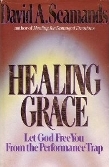Healing Grace—Let God Free You From the Performance Trap. By David Seamands. Wheaton: Victor Books, 1988. 192 pp. Cloth, $14.99.
Over the years, there have been many books written about the theology of grace. But in Healing Grace, Dr. David Seamands has given us a book that powerfully demonstrates how grace can practically impact our everyday life.
The subtitle, Let God Free You From the Performance Trap, reveals Seamands’s intended audience-believers who to one degree or another have bought the lie that who we are, how we feel about ourselves, and how God and others feel about us depends on our performance. Seamands suggests that while most Christians believe in grace (the favor of God freely given in spite of performance), they have trouble applying it to their lives. The result is a life of emotional and spiritual pain, demonstrated in low self-esteem, guilt, negative feelings, problems in relationships, and an insecure relationship with God. Seamands wants to free believers from the painful performance trap.
To this reviewer, who has himself experienced firsthand the pain of the performance trap, Seamands’s efforts to provide healing instruction are an unqualified success. In fact, he accomplishes his goal in three specific ways.
First, he exposes key barriers to grace-those factors in our lives and culture that distort grace and lead to an addiction to performance. Especially helpful is the section on grace in the home (chap. 3) with instruction on avoiding the abuse of grace (“parental dysgrace”) as well as positive teaching about communicating unconditional love to children.
Second, Seamands describes in detail the journey of an average believer from early hurts all the way to perfectionism with its many destructive tendencies (chap. 6). The clarifying chart alone (pp. 90–91) is worth the price of the book, as the author helps us “see” if perfectionism has somehow infiltrated our lives.
Third, he encourages us with a sure hope of recovery and attempts to lead us through the recovery process by saturating us in healing grace. Especially poignant is his emphasis on the necessity of grace being fully realized in our emotions. Specific chapters on grace and guilt (chap. 8) and self-esteem (chap. 10) help provide the application.
But perhaps Healing Grace accomplished a more far-reaching (though secondary) purpose by providing some much-needed insight into the current debate on the Gospel. Seamands does this in three ways:
First, he is amazingly clear in his statements concerning justifying grace. The focus in justification is not on turning from sin or any other part of our performance, but on “Christ’s perfect performance for us” (p. 169). Faith is clearly defined as “trust” (p. 81), not “commitment” (p. 36). The focus of Seamands’s Gospel is not on the quality of our faith, but its Object.
Second, he provides proper biblical emphasis on the relationship between faith and works in sanctification. He suggests that “we are most certainly called to respond to grace with obedience,” not to earn God’s grace, but simply out of “thankfulness for it” (p. 114). Guilt and fear of possible condemnation are not needed to “hold us in line” or to motivate us to serve Christ. Instead, grace is the most effective motivation for the Christian life. The author admits that all believers sin, sometimes even severely and continuously. And he includes an extensive discussion of the concept of “failure” in the Christian life. Assurance for the author is based not on works, but on grace, and it is available “in spite of all the sins and failures we see in ourselves” (p. 169).
Third, Seamands reminds us that there are other reasons to believe in the doctrine of Free Grace besides solid exegesis and theological thinking. Simply put, grace works! The only way to have the peace, joy, emotional health, and long-term productivity that God desires for His children is to believe and live the truth that “grace and grace alone is and always will be the basis of our relationship with God” (p. 110). Performance, so central to the Lordship view of motivation in the Christian life, is neither the basis nor the proof of receiving grace. To Seamands, true biblical performance flows out of experiencing grace.
In years to come, the practical side of the grace issue may gain more and more prominence in the debate over the Gospel. If that is true, I believe that this book will prove to be an invaluable asset, not only to the individual caught in the performance trap, but to the pastor and theologian who desire to apply and defend the Free Grace Gospel on a practical level.
J. Kevin Butcher
National Board Member, Grace Evangelical Society
Pastor, Grace Community Church
Detroit, MI

